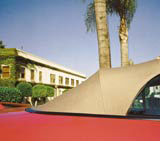Legendary moments
Richard Clayton captures the atmosphere at a retrospective exhibition of work by photographer William Eggleston at the Hayward Gallery

In 1976, William Eggleston was vilified for elevating colour photography into the realms of high art. His exhibition at New York’s Museum of Modern Art was slammed as ‘vulgar’ by the critics. Now, the original shoot-from-the-hip auteur is grandaddy cool to photographers Larry Clark, Nan Goldin, Martin Parr and countless fashion spreads.
There was always more than an outlaw stance and snapshot technique to Eggleston’s approach. He’s as much the darkroom dabbler as the next guy. That becomes apparent as you mosey round his retrospective at the Hayward Gallery in London. The signature images of languid Americana have that rare quality of intense, synthetic brightness – one that’s getting rarer all the time. As the man himself might drawl, ‘They don’t make ’em like that anymore.’
The dye-transfer process with which Eggleston alchemises his most distinctive work is a dying art. Kodak has long ceased production of the materials required. However much the photographer hoards his six-year stockpile, each new print is one frame nearer the last of its kind. Close association with this mode of technology has patented his sensibility, saturating his world with hyper-real colour. A quick glance at the black and white stills of 1960s and you see how fundamental that is to his sense of composition.
Of the Georgia, Mississippi and Tennessee scenes, Eggleston insists, ‘These photos could have been taken anywhere.’ Over the years, he’s both played up to and abhorred the Southern gent stereotype. He regularly claims a purely aesthetic intent, but once joked his pictures were structured like the Confederate flag, with objects in four corners and the fulcrum in the middle. Thus he has become a legend in own lifetime.
To be sure, certain images are pretty and vacant, yet it’s not all vapid beauty. The shock of the banal has faded into a sort of nostalgia. Pictures of diners, motels and parking lots reify a seemingly timeless period in the Deep South. They conjure up every AM-radio rock song about folks called Bobby and Loretta. And many could be cinematic set-ups. This, after all, was the era of ‘Easy Riders and Raging Bulls’. Could a young Jack Nicholson be playing the lead, somewhere out of shot? How ‘real’ it ever was is a moot point.
Eggleston describes his work as ‘part of a novel I’m doing’ and you can’t help narrativising the content. What are the secrets of the chipmonk-faced kid next door? Has that green-tiled shower room been cleaned up after a murder? Then there’s the malevolent foreboding somehow recessed in a red ceiling, the most obvious evidence of his influence on film-maker David Lynch.
Eggleston has an eye for the oddities of size and perspective. He puts a tricycle hugely in the foreground, like a relic from a suburban moon landing. A picture of a truck is a massy vision of horsepower. More recent images continue to look at things close-up, bearing out his interest in the ‘semi-abstract’.
However, Eggleston’s not lacking humour. He sees a neighbourhood watch sign when there’s no one for miles around. Elsewhere, he’s transfixed by the thighs of an inflatable Lara Croft. With the lightjet prints of his Kyoto project, often opaque and shot through glass, he appears at a loss for focus though. It’s as if, for all his professed itinerancy, Eggleston is happiest on home soil.
William Eggleston runs at the Hayward Gallery, South Bank, London, SE1 until 22 September
-
Post a comment



